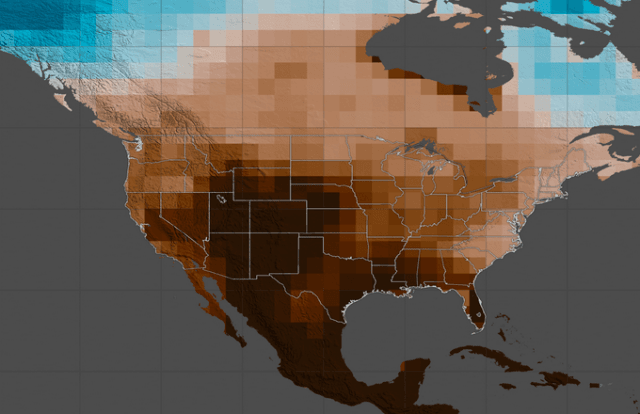A new map unveiled by the NASA Earth Observatory this week shows that the risk of “megadrought”–a severe drought lasting for up to 35 years – is increasing, and not just for the already drought-stricken California.
The map shows expected levels of soil moisture at the end of the 21st century, according to the Weather Channel. Brown shading is used to depict soil that is drier than the 20th century average, while blue shading is used to depict wetter-than-average soil.
The map utilizes existing climate models to show that if greenhouse gas emissions continue at current levels, the Great Plains and Southwest United States could see the worst droughts recorded in at least 1,000 years.
The map was created as part of a February study conducted by NASA that found that increased carbon emissions could lead to an increase in the risk of long-term drought.
“Natural droughts like the 1930s Dust Bowl and the current drought in the Southwest have historically lasted maybe a decade or a little less,” NASA climate scientist Ben Cook wrote in the February report. “What these results are saying is we’re going to get a drought similar to those events, but it is probably going to last at least 30 to 35 years.”
That could be particularly troublesome for drought-wracked California, which is already struggling to alleviate the worst effects of its water shortages. In a widely-read Los Angeles Times editorial this month, NASA senior water scientist Jay Famiglietti warned that the state “has no contingency plan for a persistent drought like this one (let alone a 20-plus-year mega-drought), except, apparently, staying in emergency mode and praying for rain.”
Compounding the problem is a recent measurement of the snowpack in the Sierra Nevada mountains–a crucial source of water for central and southern California–that showed water content levels at a historic low of just 12 percent average.
Last week, California imposed sweeping new restrictions on urban water users in attempt to fight the drought. Among the new rules: Golden State residents can only water their lawns twice per week, while restaurants must ask patrons whether they would like water before they can serve it.
Also last week, California Gov. Jerry Brown unveiled a $1 billion drought relief package that includes spending on drinking water protections, recycling programs and desalination plants.
The state’s plan to battle the drought is undoubtedly underway in earnest, although according to NASA, it may already be too late: NASA’s February report predicted that if the country can significantly curb greenhouse gas emissions by 2050, there is still a 60 percent chance of a decades-long drought occurring by the end of the 21st century. If greenhouse gas emissions continue at current levels, that risk of megadrought spikes to 90 percent, according to NASA predictions.

COMMENTS
Please let us know if you're having issues with commenting.